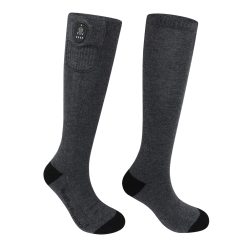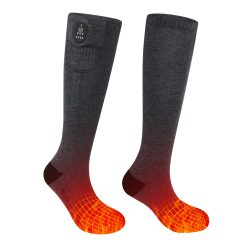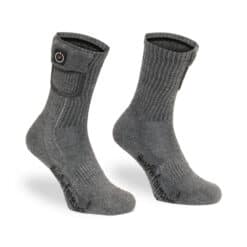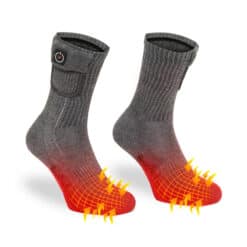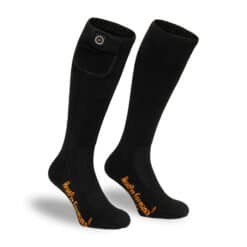Cold hands and feet, Socks
What are the best warm socks against cold feet?
Wearing a pair of warm socks helps prevent cold feet. But then, what are the best socks that keep your feet warm? Are there any socks that warm your cold feet? And do you choose socks made of cotton, wool or polyester?
To answer all these questions, we will first take a closer look at the types of materials commonly used for socks.
Then we give you a concise conclusion.
Next we put the types of materials for each activity in a convenient chart.

We also answer the question of whether thick socks are necessarily better. What do you think?
And at the very bottom of this article, we have compiled for you the best tips to prevent cold feet. And keep warm feet.
Enjoy reading!
Material Types
An important part of warm socks, of course, is the material they are made of. Each material type has its own characteristics that can contribute to a warm sock in a positive way.
This is because a good warm sock not only retains heat well but is also good at wicking away perspiration.
By clicking on the buttons below you will learn more about the properties of the most commonly used materials for socks.

Conclusion Material
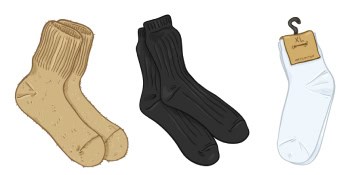
Each activity its own sock
You choose the best warm socks for your feet based on the activity you will be undertaking. Have a long work day ahead of you or are you going to exercise intensively?
LIST THE MAIN CONCLUSIONS:
-
When sitting still for a long time
Spend an evening on the couch or have a work day ahead of you at your desk? Then wearing wool socks is a good idea. Choose merino or alpaca wool, for example. These wools do not itch and retain warmth around your feet well.
-
On quiet days
Like wool, acrylic is also a good heat insulator. Acrylic, unlike wool, is unable to retain moisture. Moisture cannot transport acrylic well either. In short, acrylic socks keep your feet well warm if you are going to sit still for long periods of time.
-
During intense exercise
For intense exercise, wool is not recommended. This natural material cannot drain perspiration properly. It’s better to choose socks that include Coolmax, bamboo or polyester. These materials are capable of wicking away moisture.
-
Always avoid
Cotton socks are best left aside. Cotton does not retain heat and cannot wick away sweat. In addition, cotton has the property of lubbing quickly. So not a good choice if you suffer from cold feet easily!
-
Extra wear resistant
The addition of polyamide makes the sock extra hard-wearing and durable. Polyamide socks are also a good choice if you are prone to sweaty feet. This fabric is good at wicking away moisture.
-
For an elastic sock
To keep the sock from pinching anywhere and comfortable, the addition of elastane is indispensable. Not too much, because elastane has no insulating or moisture-wicking properties.
Material types by activity
Which socks best keep your feet warm? It depends on what you plan to undertake. In the chart below, you can determine which types of materials are best to go for.
At rest | Moderate exercise | Intense exercise | |
Wool | ✓ | max 40% | x |
Acrylic | ✓ | max 40% | x |
Coolmax | x | ✓ | ✓ |
Bamboo | x | ✓ | ✓ |
Polyester | x | ✓ | ✓ |
Polyamide | x | ✓ | ✓ |
Elastane | max 10% | max 10% | max 10% |
Cotton | x | x | x |
Fact or fable
The thicker the sock, the warmer it keeps your foot
Do you know the right answer?
It seems so obvious…. but this statement does not always hold true. If you wear thick socks in your shoes, chances are your shoes will be too tight.
This is not conducive to warm feet for two reasons:

1. Circulation
- Your blood circulation is hampered by this.
The more obstruction in blood circulation, the less well the warm blood can reach your feet.
In addition, your feet contain mostly small capillaries. Another reason why your bloodstream has difficulty reaching these ends.
2. Air layer
- Incredibly important for warm feet is creating a layer of air between the sock and your shoe.
In this layer of air, the moisture that has been removed to the outside by bamboo or polyester, for example, can evaporate. If this layer of air is not there, the moisture has nowhere to go and it quickly becomes clammy and therefore cold around your feet.
Conclusion
- If you choose a thicker sock, wear it in shoes that are a size larger.
It is a good idea to buy your winter boots, winter hiking boots or your ski boots in a size larger by default if you do plan to wear thick socks in them.
Warm and prevent cold feet
Once your feet are cold, it is not easy to get them warm. Of course, you can take a warm foot bath, but…prevention is better than cure. Here come the best tips for getting and keeping warm feet:








